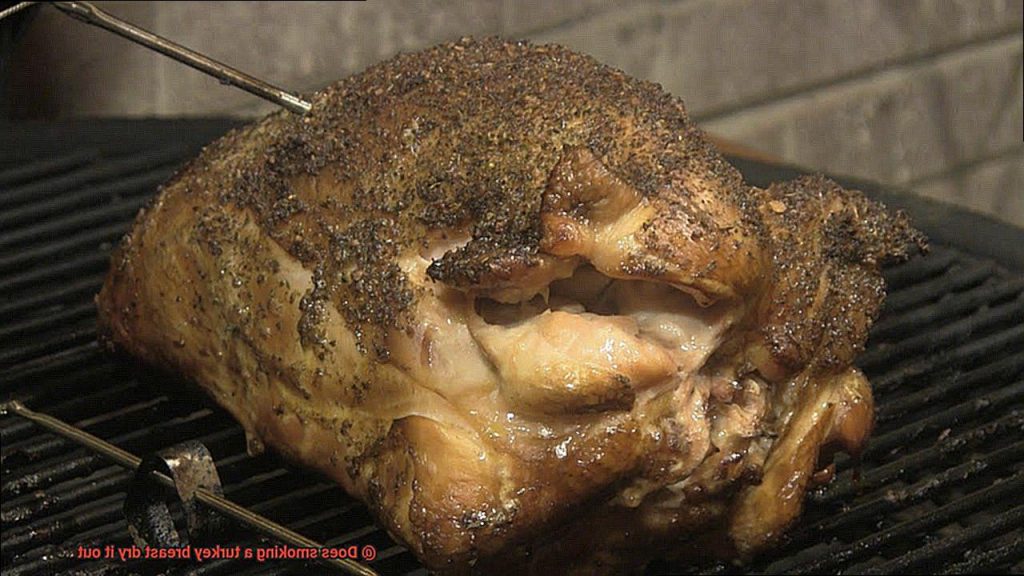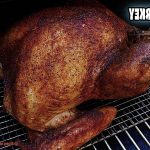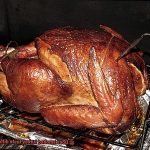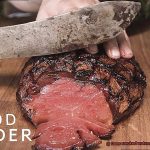Turkey is undoubtedly a crowd-pleaser, especially during festive seasons. It’s a mouth-watering protein that can be cooked in different ways to suit your taste buds. One popular method of cooking turkey is smoking it. Smoking is a slow-cooking process that imparts a unique smoky flavor while keeping the bird moist and succulent. However, there’s a widespread misconception that smoking turkey dries it out.
The truth is that smoking turkey breast does not necessarily dry it out. In fact, many culinary experts consider smoking as the best way to cook turkey breast because it retains the natural juices and flavors while adding an irresistible smoky taste. Moreover, smoking can add an extra layer of texture to the meat, making each bite unforgettable.
Nonetheless, there are crucial factors you need to keep in mind when smoking turkey breast to avoid drying it out. These include using a meat thermometer to ensure that the turkey breast is cooked up to a safe temperature and monitoring the smoker’s temperature to prevent overheating the meat.
Whether you’re an experienced chef or just starting with smoking turkey, knowing how to avoid drying out your bird can mean the difference between serving up an unappetizing dry turkey or one bursting with juicy flavors. So keep reading for an in-depth understanding of whether smoking a turkey breast dries it out or not – we’ve got you covered.
Contents
What is Smoking Meat?
Smoking meat is a culinary technique that has stood the test of time. Initially used for preservation purposes, it involves exposing meat to smoke from burning wood or charcoal for an extended period.
Today, smoking is more about flavor than preservation and is a popular way to cook meat during the summer months. Let’s explore the history of smoking meat, the different types of wood used, the various types of smokers available, and how to prevent dryness when smoking meat.
Preservation Method Turned Culinary Delight
Smoking meat was an essential preservation method before refrigeration. It involved hanging meat over a fire and allowing the smoke to do its work by removing moisture, adding salt, and providing smoke flavor. This method allowed people to store meat for more extended periods without spoiling. As time passed, people began to realize that smoking meat not only preserved it but also provided a unique smoky flavor that made it a culinary delight.
Types of Wood and Their Influence on Flavor
The type of wood used for smoking can affect the flavor of the meat. Different types of wood have different flavors, and some are better suited for specific types of meat. Hickory wood is commonly used for smoking pork, while mesquite wood is popular for beef. Choosing the right type of wood is essential to achieve the desired flavor.
Types of Smokers and Their Advantages
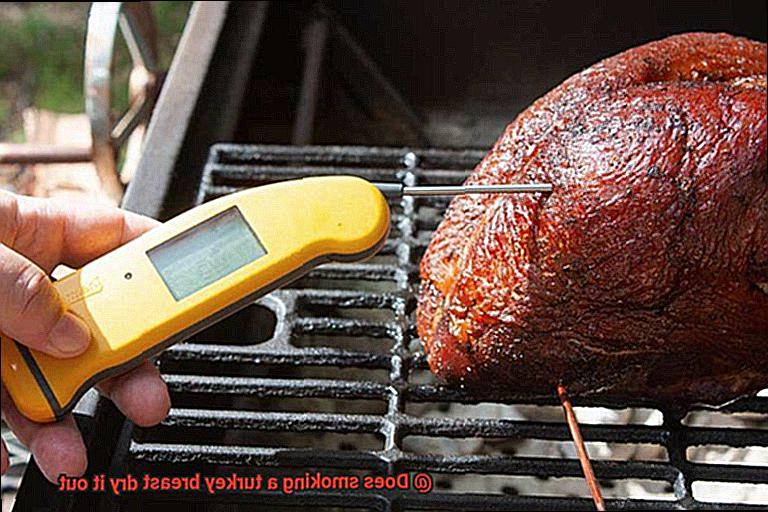
There are various types of smokers available in the market today, including electric smokers, gas smokers, charcoal smokers, and wood smokers. Each type of smoker has its advantages and disadvantages. Electric smokers are easy to use and control, while charcoal smokers provide a more traditional smoky flavor. Gas smokers offer convenience, while wood smokers allow for more control over temperature and smoke levels.
Preventing Dryness: The Key to Tender and Juicy Meat
While smoking meat can result in tender and juicy meat, there is a risk of overcooking or drying out the meat if it’s not done correctly. It is crucial to monitor the temperature and cooking time carefully to achieve the desired result. For leaner cuts like turkey breast, it’s essential to take certain precautions like brining it before smoking and monitoring the temperature to prevent dryness.
Why is Smoking a Turkey Breast Risky?
While this cooking method is popular, it’s important to note that smoking a turkey breast can pose some risks. As an expert in the field, I’m here to tell you why.
Smoking meat is a slow and low cooking process that typically takes several hours at around 225°F. This temperature range is perfect for creating tender meat, but it can also create an environment for harmful bacteria to breed if the turkey breast is not handled or cooked properly.
Here are some reasons why smoking a turkey breast can be risky:
- Low Cooking Temperature – The low temperature of smoking can be a breeding ground for bacteria if the turkey breast is not cooked to the correct internal temperature.
- Long Cooking Time – The prolonged cooking time makes it harder to ensure that the turkey breast has reached the proper internal temperature throughout.
- Drying Out – The low temperature and long cooking time can cause the moisture in the meat to evaporate, resulting in dry and tough texture.
To ensure that your smoked turkey breast comes out delicious and safe to eat, here are some tips:
- Check the internal temperature of your turkey breast with a meat thermometer. The USDA recommends poultry be cooked to an internal temperature of 165°F.
- Store your turkey breast at or below 40°F before smoking to prevent any bacteria growth.
- Use separate cutting boards and utensils for raw poultry to avoid cross-contamination.
- Consider brining your turkey breast before smoking to keep it moist and flavorful.
The Benefits of Brining a Turkey Breast Before Smoking
Look no further than the simple technique of brining. Brining a turkey breast before smoking involves soaking it in a saltwater solution along with other seasonings for several hours. Let’s explore the benefits of brining and why it’s worth the effort.
- Moisture Retention: The salt in the brine helps to break down the muscle fibers in the turkey, allowing it to absorb more moisture during the smoking process. This translates to a juicy and tender finished product rather than a dry and tough one.
- Flavor Infusion: With the addition of various spices or herbs to your brine, your turkey can be infused with extra flavor. From classic rosemary and thyme to adventurous cumin and coriander, brining allows for customized seasoning to your taste preferences.
- Salt Balance: It’s important to be mindful of the amount of salt used in your seasoning blend when brining a turkey breast. Since it already absorbs salt from the brine, over-seasoning can lead to an overly salty finished product. But with careful measurements, you’ll achieve that perfect balance of saltiness and flavor.
How to Monitor the Temperature When Smoking a Turkey Breast
Smoking a turkey breast can be a mouthwatering culinary experience, but it’s important to ensure that the meat is cooked to perfection. This requires monitoring the temperature of the turkey breast throughout the cooking process. Here are five key tips to keep in mind when monitoring the temperature:
Tip #1: Use a Meat Thermometer
A meat thermometer is an essential tool for smoking a turkey breast. Whether you opt for an analog or digital thermometer, make sure it is reliable and accurate. Insert the thermometer into the thickest part of the meat, avoiding contact with any bones, and take multiple readings from different parts of the turkey breast. For larger cuts of meat, consider using a wireless thermometer that allows you to monitor the temperature without opening the smoker door.
Tip #2: Maintain a Steady Temperature
Maintaining a steady temperature is crucial when smoking a turkey breast. The ideal temperature range for smoking is between 225-250°F, but fluctuations can occur if your smoker isn’t properly insulated or ventilated. Keep an eye on the temperature gauge throughout the cooking process and adjust the smoker as necessary to maintain a consistent heat.
Tip #3: Cover the Breast Meat
Turkey breasts can dry out quickly during smoking due to their leanness. To prevent this from happening, cover the breast meat with foil once it reaches an internal temperature of 150°F. This will help keep the moisture inside while allowing the rest of the turkey to cook thoroughly.
Tip #4: Brine the Turkey Breast
Brining is another way to keep your turkey breast moist and flavorful. Soaking the meat in a saltwater solution for several hours before smoking allows it to absorb moisture and flavor. You can also add butter or oil to the turkey breast before smoking to help retain moisture.
Tip #5: Calibrate Your Thermometer
Before each use, calibrate your thermometer to ensure it’s reading accurately. Calibration involves checking the thermometer’s accuracy against a known temperature source, such as boiling water or ice water. This step is crucial to ensure that you’re getting reliable temperature readings throughout the cooking process.
Butter or Oil: Additional Moisture for the Turkey Breast
Smoking requires precise attention to detail to achieve perfection. In the previous section, we discussed some essential tips to help you become an orchestra conductor in your kitchen. Now, let’s talk about another crucial aspect of smoking a turkey breast: adding additional moisture with butter or oil.
Both butter and oil can help keep your turkey breast moist during smoking. Butter has a rich taste that can add depth to the turkey’s flavor profile, while oil is more neutral in flavor but still provides added moisture. However, both can also add extra fat to the turkey breast. If you’re watching your calorie intake or prefer leaner meat, this may not be ideal for you.
To use butter or oil on your turkey breast, there are two ways to do it. First, you can brush melted butter or heated oil onto the surface of the turkey breast before placing it in the smoker. Make sure you coat the entire surface for even cooking and moisture distribution.
Alternatively, you can inject a mixture of butter or oil and other flavorful ingredients such as herbs or spices into the turkey breast. This method allows for deeper penetration of moisture and flavor into the meat, resulting in a more flavorful and moist final product.
If you’re a fan of rich flavors and don’t mind added fat, go ahead and use butter. But if you prefer a neutral flavor profile and want to keep things leaner, oil might be your best option.
When using either method, be mindful of any potential health concerns related to consuming additional fat. Ultimately, whether you use butter or oil on your smoked turkey breast is a personal preference.
How to Know When the Turkey Breast is Done
Smoking a turkey breast can be a mouthwatering and exciting way to cook this lean cut of meat. However, determining when the turkey is fully cooked can be challenging. Overcooking can lead to dry meat, while undercooking poses a risk to your health. But don’t worry, with these tips you’ll know how to tell when your smoked turkey breast is done and safe to eat.
Use a Meat Thermometer
The most reliable method to determine whether your turkey breast is cooked is by using a meat thermometer. Insert the probe into the thickest part of the breast, being careful not to touch the bone. The USDA recommends cooking turkey breast to an internal temperature of 165°F (74°C) for safe consumption. Once the thermometer reads this temperature, remove the turkey breast from the smoker and let it rest for at least 10-15 minutes before carving.
Check the Color
Another way to check if your turkey breast is fully cooked is by observing its color. A perfectly cooked turkey breast should have an even, golden-brown hue on the outside. If there are any areas that look pale or pinkish, it’s likely that it needs more time in the smoker.
Test the Juices
Pierce the turkey breast with a fork or knife, and check the juices that come out. If they are clear, then your turkey is done. However, if they are still pink or red, it needs more cooking time. Juices that are pink or red indicate undercooked meat and are unsafe for consumption.
Give it a Gentle Squeeze
You can also determine if your turkey breast is done by giving it a gentle squeeze. If it feels firm to the touch and not squishy or soft in any areas, it’s likely fully cooked. However, be careful not to overdo it as squeezing too hard may cause juices to leak out and dry out the meat.
Monitor Cooking Time
Smoking a turkey breast takes longer than traditional oven roasting due to the lower cooking temperature. Therefore, it’s necessary to monitor the internal temperature and overall cooking time to ensure that it is cooked through but not overdone. Overcooking results in a dry and tough bird.
Common Mistakes to Avoid When Smoking a Turkey Breast
Smoking a turkey breast can be a delicious and satisfying culinary experience, but it’s all too easy to make mistakes that can ruin the bird. To avoid these pitfalls, it’s essential to understand some of the most common mistakes and how to sidestep them.
One of the biggest mistakes people make when smoking a turkey breast is failing to brine it properly. Brining is a process in which you soak the turkey in a saltwater solution for several hours before cooking. This helps to keep the meat juicy and tender during the smoking process, preventing it from becoming dry and tough.
Another pitfall is using too much smoke or cooking at too high of a temperature. While smoke can add depth and complexity to the flavor of the meat, too much of it can overwhelm the delicate taste of turkey and make it bitter. Plus, cooking at high temperatures can quickly dry out the meat, leading to unpleasantly chewy texture.
To avoid these issues, it’s important to maintain a consistent temperature throughout the smoking process by keeping the smoker closed as much as possible. Resist the urge to open the smoker frequently, as this can cause temperature fluctuations and extend cooking time.
Lastly, once your turkey breast is smoked to perfection, resist carving it right away. Letting it rest for at least 10-15 minutes allows the juices to redistribute throughout the meat, resulting in a more tender and flavorful final product.
In addition to avoiding these common mistakes, there are other tips and tricks that can help you achieve smoked turkey breast perfection. Use a meat thermometer to ensure that the internal temperature of the bird reaches 165°F before serving. Check for color changes in the meat and test for clear juices. Give your bird a gentle squeeze – it should feel firm but still have some give.
dQTxaA20Hx0″ >
Conclusion
In conclusion, smoking a turkey breast can actually enhance its natural juices and flavors when done correctly. Culinary experts swear by this method as it adds an irresistible smoky taste that is hard to resist. However, it’s crucial to keep in mind that smoking requires some attention to detail to avoid drying out the meat.
To prevent dryness, use a meat thermometer to ensure that the turkey breast reaches a safe temperature while monitoring the smoker’s temperature to prevent overheating. Another way to retain moisture and flavor is by brining your turkey breast for several hours before smoking. This process allows the meat to absorb moisture and flavor, resulting in a juicy and flavorful turkey breast.
Adding butter or oil before smoking also helps retain moisture in the meat. To ensure your smoked turkey breast is safe to eat, check its internal temperature with a meat thermometer. The USDA recommends poultry be cooked up to an internal temperature of 165°F.
Before smoking, store your turkey breast at or below 40°F to avoid any bacteria growth. Additionally, use separate cutting boards and utensils for raw poultry to prevent cross-contamination.
Avoid common mistakes such as improper brining techniques, using too much smoke or cooking at high temperatures, frequently opening the smoker, or carving right after smoking.

